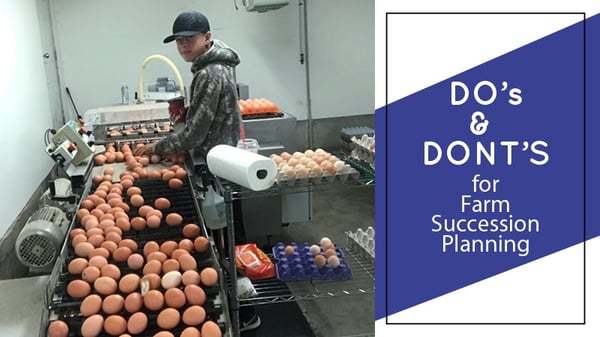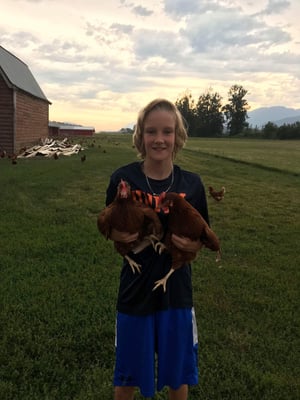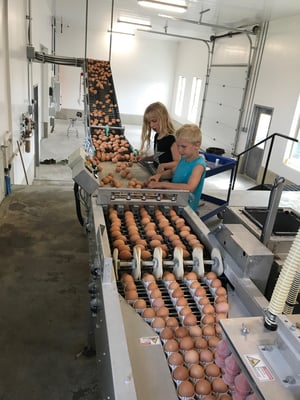Farm succession planning is a process that should be started sooner than later.
Tough questions have to be asked. Is there a potential successor? If yes, does he or she have the skills, abilities, knowledge and desire to successfully operate a sophisticated farm business in today’s agricultural economy? If there is no successor, what are the options? Is selling part or all of the farm assets an option? How long does the current operator(s) want to continue running the business? Only the individual(s) involved can answer these questions.

Here are some do’s and don’ts to help start the process.
Do’s
-
Do think of succession planning as a process rather than an event. It takes time and effort.
-
Do start planning now. The earlier planning begins, the greater the number of options.
-
Do keep the big picture — the long-term direction of the farm business — in mind. Maintaining a positive attitude can make all the difference.
-
Do complete a financial analysis of the past and present farm business along with some financial projections. Profitability is a key piece of the puzzle — the “show stopper” when it comes to developing a succession plan. If the farm is not making money now, what can be done to make it profitable? Is the farm business viable in the long run?
-
Do become educated about the subject — take workshops and seminars, read articles, complete self-assessment questionnaires related to succession; become an active participant in the planning process.
-
Do consider using a “family business meeting” as a way to open the lines of communication among family members. An objective, third-party facilitator can help ensure that the initial meetings run smoothly and everyone has an opportunity to voice their interests and concerns.
-
Do determine the most important things (values and their priorities) to each individual family member as a starting point. The business meeting mentioned above can be helpful with this.
-
Do figure out each individual’s personal, family and business goals, which should be based upon their values and priorities.

-
Do ensure good communication among family members about plans, strategies and issues.
-
Do address the issue of fair (equitable) vs. equal division of the farm early in the process — especially if there are off-farm family members involved.
-
Do prepare a legal will early. A will can provide guidance on how the estate should be settled.
-
Do develop a “successor development plan” for any family member(s) who is (are) planning to take over the business. This is a plan to train and develop the successor(s), so he/she has the appropriate skills and knowledge to successfully run the business.
-
Do generate and discuss various options — be creative. These can be narrowed down over time.
- Do assemble a “team” of professional advisors (e.g., a lawyer, accountant, financial planner, banker, etc.) and work with them; communicate with them and ensure they fully understand what is wanted. Once there are some clear ideas of how the transfer might take place, the team of advisors can assist in looking at the pros and cons of certain ideas. The family members involved will decide upon the best plan and strategies for their situation.
- Do take responsibility for development and implementation of the plan with help from the advisors. But remember, this is the family’s plan, not the advisors’. Family members have to buy into the plan for it to be successful.
- Do consider the tax implications, but don’t focus solely on them as the most important thing. For example, rather than saying, “We don't want to pay any taxes,” make your goal, “Transfer the farm business efficiently and effectively while considering the tax consequences and preserving as much family capital as possible.
- Do write it down. By writing it down, all family members see exactly how the plan will unfold, which can help avoid future misunderstandings.
The advisors can help document and fine-tune the plan. Basically, the plan is the record of the decisions you make about how the transfer of labour, management and ownership will be handled. It describes how best to achieve what family members want to have happen to the farm business. It must be internally consistent and address the goals and plans for the family members and for the business.
Don’ts
-
Don’t procrastinate — start talking and planning for succession now.
-
Don’t be afraid to ask questions and listen carefully to the answers, even though you might not like them.
-
Don’t assume you know what others are thinking or how they feel about the process or what they want to achieve from the succession plan. Listen carefully and ask questions if you don’t understand.
-
Don’t be afraid to share responsibilities. Both generations will need to work together to ensure the optimum transfer of labour, management and ownership. The “successor development plan” mentioned above can help.
-
Don’t define life as the business. There is more to life than work — family, friends, leisure enjoyment, sports, hobbies, etc.
-
Don’t put all your eggs in one basket. Plan ahead, think early about retirement, save and invest off-farm, so you will have some options in the future.
-
Don’t rely on just one professional advisor — it is a good idea to use a team approach.
Source: Ontario Ministry of Agriculture, Food and Rural Affairs
Thank you to our customer Country Golden Yolks for the photos!



